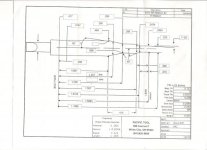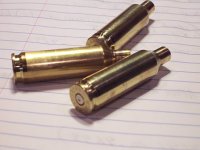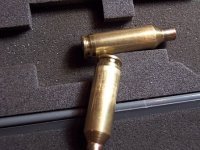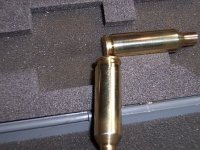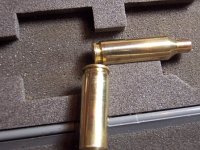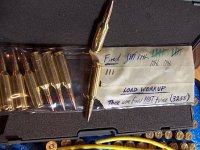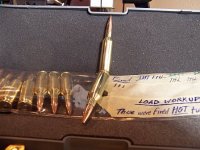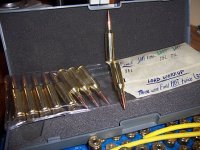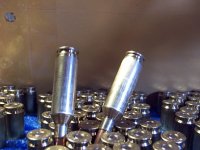You are using an out of date browser. It may not display this or other websites correctly.
You should upgrade or use an alternative browser.
You should upgrade or use an alternative browser.
Al's 6x47L
- Thread starter Law Dawg
- Start date
I've only got time to post the reamer print right now.
You'll notice that this is a "6BR Reamer" that's been fattened and shortened about 60 thou. This print shows a 1 1/2 degree leade. This nomenclture is the result of my Scotch nature my first "6X47L" is made with one of my other 6BR reamers. I've got three 6BR reamers all .002 apart from each other, this is "#3" and the largest at .009 over virgin brass. My smallest is .005 over and the "#2" is fattified to .007 over.
my first "6X47L" is made with one of my other 6BR reamers. I've got three 6BR reamers all .002 apart from each other, this is "#3" and the largest at .009 over virgin brass. My smallest is .005 over and the "#2" is fattified to .007 over.
My lot of brass measures about .4687 at the web and in use this brass expands about .009 over base dimension. I'll try to post some pix of the fired brass soon so's you can see just how fat this is. It makes a visible bulge when the case has sizing scratches on it. Polished, the bulge is much less apparent.
Again, I'll try to post pix as I get them taken and loaded up.
Let's see how the print looks.
There is one dimension marked ".4747" at .020 forward of the boltface which I question but I'm assuming that Kiff figured it right...... I left that space blank on my spec'd print.
al
I previewed the print, it looks like I sized it too small. Let me know can you read it.....
You'll notice that this is a "6BR Reamer" that's been fattened and shortened about 60 thou. This print shows a 1 1/2 degree leade. This nomenclture is the result of my Scotch nature
My lot of brass measures about .4687 at the web and in use this brass expands about .009 over base dimension. I'll try to post some pix of the fired brass soon so's you can see just how fat this is. It makes a visible bulge when the case has sizing scratches on it. Polished, the bulge is much less apparent.
Again, I'll try to post pix as I get them taken and loaded up.
Let's see how the print looks.
There is one dimension marked ".4747" at .020 forward of the boltface which I question but I'm assuming that Kiff figured it right...... I left that space blank on my spec'd print.
al
I previewed the print, it looks like I sized it too small. Let me know can you read it.....
Attachments
J
Jay Idaho
Guest
What do you use for a FL die and how much do you squeeze the base down? I'm really curious at to why you spec chambers .009 over factory brass.
Jay, Idaho
Jay, Idaho
R. G. Robinett
New member
I've only got time to post the reamer print right now.
You'll notice that this is a "6BR Reamer" that's been fattened and shortened about 60 thou. This print shows a 1 1/2 degree leade. This nomenclture is the result of my Scotch naturemy first "6X47L" is made with one of my other 6BR reamers. I've got three 6BR reamers all .002 apart from each other, this is "#3" and the largest at .009 over virgin brass. My smallest is .005 over and the "#2" is fattified to .007 over.
My lot of brass measures about .4687 at the web and in use this brass expands about .009 over base dimension. I'll try to post some pix of the fired brass soon so's you can see just how fat this is. It makes a visible bulge when the case has sizing scratches on it. Polished, the bulge is much less apparent.
Again, I'll try to post pix as I get them taken and loaded up.
Let's see how the print looks.
There is one dimension marked ".4747" at .020 forward of the boltface which I question but I'm assuming that Kiff figured it right...... I left that space blank on my spec'd print.
al
I previewed the print, it looks like I sized it too small. Let me know can you read it.....
Al, I believe that the datum point which you list as being 0.020" , should be 0.200" ahead of the bolt-face, or, just above the extractor groove. If the drawing is correct - that is, it matches the reamer - your cases should be able to expand no more than 0.006" (0.4747 minus .4687). Is this the 'middle' print? RG
Last edited:
What do you use for a FL die and how much do you squeeze the base down? I'm really curious at to why you spec chambers .009 over factory brass.
Jay, Idaho
Jay, I have three 6BR reamers that're sized .002 apart. To use them you use a MINUS .002 as the sizing reamer for the chambering reamer. Even an un-hardened sizer works fine provided you use die wax. I've got 6X47L cases that have been fired 37 times so far and have grown only .001.
I spec the reamers this large for two reasons, both important to ME.
Number one, I hate the "click", won't live with it.
Number two, I use the swelling to sort my brass for runout. I don't know if this is important or not but it makes it dead easy. I can show pix if you want.
al
Al, I believe that the datum point which you list as being 0.020" , should be 0.200" ahead of the bolt-face, or, just above the extractor groove. If the drawing is correct - that is, it matches the reamer - your cases should be able to expand no more then 0.006" (0.4747 minus .4687). Is this the 'middle' print? RG
Randy you're right on the .200, duhhh
On the other, this reamer is a 6BR being used as a 6X47L..... I'll go down and measure some cases for swelling. I may be wrong on the numbers. I've used these reamers for both 6BR and 6X47L so many times I may need to sort out my numbers before I start spouting.
Thanks for checking
al
Jim,
If you've got a fax I'll just send one over..... or email one??? Or you can order one from PPG or I can copy and MAIL you one eh???
Here are the fired case dimensions and some pictures of brass from this particular chamber.
What I've done is....... taken some brass from my other .002 smaller chambered barrel and just moved it over. Borden got the headspace so right on that the old cases were perfect snug fit in the brand new chamber! All they did was pop out to about .0014 larger in diameter at the base. These cases have been fired 10 times in my OLD chamber and only three times in the new one.
This reamer using my -.008 HS gauge, CHAMBERED BY BORDEN, yields a chamber such that:
--The MAX oal of the brass is 2.830 from boltface to end of neck. This is commonly called the "trim-to" length and my recommendation is to set the "trim-to" max length at 2.825. This gives .005 of slop..... now I DO choose to play around in the "less than this" area but you'd better make DARN SURE your die setup is perfect if you do this!!! My cases DO NOT GROW in length. A fireformed 6X47L case measures about 2.850 to the end of the neck, I trim them back to 2.828 for this chamber. That's knocking about 22thou off the fireformed case.
--The base of the case swells out to .476, I measured 4-5 cases at from .4760 to .4762. NOW THIS IS INTERESTING...... I'd never really re-measured any of these cases before. I decided to check the little strip of unsized brass just below the web and above the extractor groove. It now measures .471! The cases started at .468, the area above the extractor groove has hammered out to .471 sooo....
------NEW case .468 @ base.
------10 times FIRED case .471 @ base
------web dimension, expanded in this chamber .476+
So my estimated .009 difference is perty freakin' close! From .468 on virgin cases to .4765+ chamber which yields .476+ fired cases.
--Fired necks are coming in at .265 diameter.
I will be ordering a Harrell die for this guy shortly. So far I haven't managed to tighten up any cases to where I'd like 'em...... I've gotten too wrapped up playing with my new Shadetree tuner. If they don't tighten up perty soon I'll just set the tuner and load/fire three of them until they get tight.
If they don't tighten up perty soon I'll just set the tuner and load/fire three of them until they get tight.
Here are some pictures which hopefully will show the MASSIVE swelling from my overlarge chambers
I've got pix with scratches and without....... "without" just means I wiped them off with Nevr-Dull. My closeup skills are rudimentary so I hope y'all's can see the pertinent parts. They're kinda' repetitive but they ARE all slightly different angles/lighting trying to show the effect of the fatness.
al
If you've got a fax I'll just send one over..... or email one??? Or you can order one from PPG or I can copy and MAIL you one eh???
Here are the fired case dimensions and some pictures of brass from this particular chamber.
What I've done is....... taken some brass from my other .002 smaller chambered barrel and just moved it over. Borden got the headspace so right on that the old cases were perfect snug fit in the brand new chamber! All they did was pop out to about .0014 larger in diameter at the base. These cases have been fired 10 times in my OLD chamber and only three times in the new one.
This reamer using my -.008 HS gauge, CHAMBERED BY BORDEN, yields a chamber such that:
--The MAX oal of the brass is 2.830 from boltface to end of neck. This is commonly called the "trim-to" length and my recommendation is to set the "trim-to" max length at 2.825. This gives .005 of slop..... now I DO choose to play around in the "less than this" area but you'd better make DARN SURE your die setup is perfect if you do this!!! My cases DO NOT GROW in length. A fireformed 6X47L case measures about 2.850 to the end of the neck, I trim them back to 2.828 for this chamber. That's knocking about 22thou off the fireformed case.
--The base of the case swells out to .476, I measured 4-5 cases at from .4760 to .4762. NOW THIS IS INTERESTING...... I'd never really re-measured any of these cases before. I decided to check the little strip of unsized brass just below the web and above the extractor groove. It now measures .471! The cases started at .468, the area above the extractor groove has hammered out to .471 sooo....
------NEW case .468 @ base.
------10 times FIRED case .471 @ base
------web dimension, expanded in this chamber .476+
So my estimated .009 difference is perty freakin' close! From .468 on virgin cases to .4765+ chamber which yields .476+ fired cases.
--Fired necks are coming in at .265 diameter.
I will be ordering a Harrell die for this guy shortly. So far I haven't managed to tighten up any cases to where I'd like 'em...... I've gotten too wrapped up playing with my new Shadetree tuner.
Here are some pictures which hopefully will show the MASSIVE swelling from my overlarge chambers
I've got pix with scratches and without....... "without" just means I wiped them off with Nevr-Dull. My closeup skills are rudimentary so I hope y'all's can see the pertinent parts. They're kinda' repetitive but they ARE all slightly different angles/lighting trying to show the effect of the fatness.
al
Attachments
Here are some more pix of my workup cases. There are ten of them and this little bag has been fired as many times as there are marks on the bag. Thirty-something at the point the pic was taken.
These were fired in my "intermediate" chamber which is .007 oversized and was cut using my plain old 6BR reamer. (Well, my 5th go-round 6BR reamer. The one that I consider to be "perfect") THIS chamber has excess gapspace of around .050 because the 6BR neck is a lot longer than the 6X47L in its commonest iterations. It's shooting "large dots" of around 1/4" at 100yds. I have no real idea yet whether the problem is ME or the BARREL or the CHAMBER or the GUN SETUP or what, but since it easily holds under 1/4MOA at yardage it's still winnable-withable even now, warts and all.
(((( Now before anybody scoffs..... IME .250" agg's in the real world using large VLD bullets is perty darn good. I know that Jackie says his 6BR shot zero's with big bullets and Neilsen's gun over on 6MMBR.com "shoots dots" but I ain't Jackie and I ain't Don!
 and FOR ME this is OK. And if a 6BR with big bullets "shoots zero's" then why would ANYONE not use it in UL 200yd??? ))))
and FOR ME this is OK. And if a 6BR with big bullets "shoots zero's" then why would ANYONE not use it in UL 200yd??? ))))
pix below
al
These were fired in my "intermediate" chamber which is .007 oversized and was cut using my plain old 6BR reamer. (Well, my 5th go-round 6BR reamer. The one that I consider to be "perfect") THIS chamber has excess gapspace of around .050 because the 6BR neck is a lot longer than the 6X47L in its commonest iterations. It's shooting "large dots" of around 1/4" at 100yds. I have no real idea yet whether the problem is ME or the BARREL or the CHAMBER or the GUN SETUP or what, but since it easily holds under 1/4MOA at yardage it's still winnable-withable even now, warts and all.
(((( Now before anybody scoffs..... IME .250" agg's in the real world using large VLD bullets is perty darn good. I know that Jackie says his 6BR shot zero's with big bullets and Neilsen's gun over on 6MMBR.com "shoots dots" but I ain't Jackie and I ain't Don!
pix below
al
Attachments
S
stsbuyer
Guest
Jim,
If you've got a fax I'll just send one over..... or email one??? Or you can order one from PPG or I can copy and MAIL you one eh???
Here are the fired case dimensions and some pictures of brass from this particular chamber.
What I've done is....... taken some brass from my other .002 smaller chambered barrel and just moved it over. Borden got the headspace so right on that the old cases were perfect snug fit in the brand new chamber! All they did was pop out to about .0014 larger in diameter at the base. These cases have been fired 10 times in my OLD chamber and only three times in the new one.
This reamer using my -.008 HS gauge, CHAMBERED BY BORDEN, yields a chamber such that:
--The MAX oal of the brass is 2.830 from boltface to end of neck. This is commonly called the "trim-to" length and my recommendation is to set the "trim-to" max length at 2.825. This gives .005 of slop..... now I DO choose to play around in the "less than this" area but you'd better make DARN SURE your die setup is perfect if you do this!!! My cases DO NOT GROW in length. A fireformed 6X47L case measures about 2.850 to the end of the neck, I trim them back to 2.828 for this chamber. That's knocking about 22thou off the fireformed case.
--The base of the case swells out to .476, I measured 4-5 cases at from .4760 to .4762. NOW THIS IS INTERESTING...... I'd never really re-measured any of these cases before. I decided to check the little strip of unsized brass just below the web and above the extractor groove. It now measures .471! The cases started at .468, the area above the extractor groove has hammered out to .471 sooo....
------NEW case .468 @ base.
------10 times FIRED case .471 @ base
------web dimension, expanded in this chamber .476+
So my estimated .009 difference is perty freakin' close! From .468 on virgin cases to .4765+ chamber which yields .476+ fired cases.
--Fired necks are coming in at .265 diameter.
I will be ordering a Harrell die for this guy shortly. So far I haven't managed to tighten up any cases to where I'd like 'em...... I've gotten too wrapped up playing with my new Shadetree tuner.If they don't tighten up perty soon I'll just set the tuner and load/fire three of them until they get tight.
Here are some pictures which hopefully will show the MASSIVE swelling from my overlarge chambers
I've got pix with scratches and without....... "without" just means I wiped them off with Nevr-Dull. My closeup skills are rudimentary so I hope y'all's can see the pertinent parts. They're kinda' repetitive but they ARE all slightly different angles/lighting trying to show the effect of the fatness.
al
Are you sure the length of the case is 2.830 and not 1.830. My loiaded length of my 6.5 x 47L with 142gr Sierra Match Kings is only 2.750. Unless you talking about something other than the 6.5mm x 47 Lapua parent case.
Paul

Last edited by a moderator:
Al:
I "think" I know the answer, but it is best to ask. How do you keep your primer pockets tight with the "fat" area cut by your reamer?
Jim
Jim,
The size of the chamber has nothing to do with primer pocket expansion. Primer pocket expansion is the result of high pressure gas being metered through the flashhole into the pocket itself which then expands (or doesn't) hydraulically.
You cannot control this by cutting chambers or boltfaces tighter. All that will happen if you make the chamber smaller or the boltface smaller is that you'll stick your cases.
The casehead doesn't spring back like the rest of the case, it only gets BIGGER, (Or not), it's not "contained" in any way.
al
Are you sure the length of the case is 2.830 and not 1.830. My loiaded length of my 6.5 x 47L with 142gr Sierra Match Kings is only 2.750. Unless you talking about something other than the 6.5mm x 47 Lapua parent case.
Paul

Sorry Paul,
Good catch.
al
Lynn,
Because no resizer can resize the casehead.
It's the casehead expanding that loosens the pocket. A casehead can expand as much as .004-005 above the web before the primer gets loose.
Here's my full reason...... .005 over will reliably work to eliminate the click (I THINK) but I go even larger because this allows me to cull my cases for eccentricity simply by looking at them. Cases which expand evenly are "Match", those which scrub down one side are "Foulers" and the ones in between are "Sighters."......
See pix, case on right is "scrubbed" and case on left is evenly expanded.
edit... I just realized something. The case on the left IS NOT "evenly expanded" that's the back side of a "scrubbed" case to show how big the bulge is. An evenly expanded one doesn't show as abrupt nor as large a swelling.
al
Because no resizer can resize the casehead.
It's the casehead expanding that loosens the pocket. A casehead can expand as much as .004-005 above the web before the primer gets loose.
Here's my full reason...... .005 over will reliably work to eliminate the click (I THINK) but I go even larger because this allows me to cull my cases for eccentricity simply by looking at them. Cases which expand evenly are "Match", those which scrub down one side are "Foulers" and the ones in between are "Sighters."......
See pix, case on right is "scrubbed" and case on left is evenly expanded.
edit... I just realized something. The case on the left IS NOT "evenly expanded" that's the back side of a "scrubbed" case to show how big the bulge is. An evenly expanded one doesn't show as abrupt nor as large a swelling.
al
Attachments
Last edited:
Chambers and Pockets
Al:
This goes back a long way. At Hawks Ridge, the shooters often spec'ed out a reamer to cut a tighter fit on the rear if they were using Norma brass, as many did at the time with the 6.5x284 and 300 ackley chamberings (based on the 300 Wea). It did not really seem to help the Norma brass at all in those chamberings -- at least four generations of 6.5x284 Norma, at least one of which was a recall. As to those using RWS brass on the 300s, nothing seemed to open the pockets -- except for some very stiff loads shot by David Tooley in his 30 Boo Boo.
BTW, I will e-mail you my fax number.
Thanks,
Jim Hardy
Jim,
The size of the chamber has nothing to do with primer pocket expansion. Primer pocket expansion is the result of high pressure gas being metered through the flashhole into the pocket itself which then expands (or doesn't) hydraulically.
You cannot control this by cutting chambers or boltfaces tighter. All that will happen if you make the chamber smaller or the boltface smaller is that you'll stick your cases.
The casehead doesn't spring back like the rest of the case, it only gets BIGGER, (Or not), it's not "contained" in any way.
al
Al:
This goes back a long way. At Hawks Ridge, the shooters often spec'ed out a reamer to cut a tighter fit on the rear if they were using Norma brass, as many did at the time with the 6.5x284 and 300 ackley chamberings (based on the 300 Wea). It did not really seem to help the Norma brass at all in those chamberings -- at least four generations of 6.5x284 Norma, at least one of which was a recall. As to those using RWS brass on the 300s, nothing seemed to open the pockets -- except for some very stiff loads shot by David Tooley in his 30 Boo Boo.
BTW, I will e-mail you my fax number.
Thanks,
Jim Hardy
Al
Is this thinking correct?
Your bulging the brass then looking for a nice straight line all te way around the case? If the line around the case wanders it means the brass hasn't expanded evenly in all directions?
Lynn
That is correct, in fact it's even better than that.
Look again at the case I call "scrubbed" and you'll see that the "scrubbed" side of the case is perfectly flat clear to the base. The "scrub marks" are the scratches from the sizing die which extend clear to the end. The OTHER side, which is the left-hand case, has a pronounced swelling. Thess particular cases are quite eccentric, all of the swelling occurred on one side and the other stayed flat. This shows clearly that one side is thicker/harder than the other. Sectioning and mic'ing the cases bears this out.
I cull for concentric cases which no amount of measuring can truly find.
I can also find irregularities in the web, canted bases, etc. Cases which look clean all the way around will also have a perfectly centered firing pin strike FWIW.
shortcuts
al
Al:
This goes back a long way. At Hawks Ridge, the shooters often spec'ed out a reamer to cut a tighter fit on the rear if they were using Norma brass, as many did at the time with the 6.5x284 and 300 ackley chamberings (based on the 300 Wea). It did not really seem to help the Norma brass at all in those chamberings -- at least four generations of 6.5x284 Norma, at least one of which was a recall. As to those using RWS brass on the 300s, nothing seemed to open the pockets -- except for some very stiff loads shot by David Tooley in his 30 Boo Boo.
BTW, I will e-mail you my fax number.
Thanks,
Jim Hardy
Jim, I listened to all that crap. I spec'd my first reamers based on these "experts" opinions and have since scrapped the reamers. I've got reamers cut so tight that you can feel the base on virgin brass. What a steenking WASTE of 550 bucks a pop. I've even had cases stick in a perfectly fitted bolt face. I TRIED all this stuff and just learned to keep my mouth shut because all the "winning experts" just scoffed at my backyard tinkering.
I made some realio-trulio waves back in the mid-90's when I first found this board. This was (is) the first venue where folks from all ends of the earth can mix and mingle and clash ........ and especially back then I was a real instigator and the board was a lot hotter. Many sacred cows have been slain and what's now a "Flame War" wasn't even a warm aftrnoon back in the day. And now I can just sit back and grin as 6BR's and fitted dies and full-length sizing and weighing loads and NOT annealing and NOT jumping bullets and smaller cases and fitted necks and such make inroads into hallowed traditions. In the end the stuff that WORKS will end up on top, screw tradition........ I haven't heard the term "bump die" in YEARS thank God!!!
MAN I miss Franklin L Murphy!! Those days were GOOD..... I dream of the possibility that Wilbur saved off those old archives in a file somewhere. This board has been wiped out so many times now that I totally forget how much ground it's covered through the years!
I DON'T CARE that my fat ugly cases look funny! Form Follows Function, I want stuff to WORK! Life's too short.
LOL
al
J
Jay Idaho
Guest
The real severe "pregnant" looking fired brass that I've seen were always from controlled feed rifles. I thought that the brass was being held off-center by the striff extractor as the pressure built inside the case. The case head made contact with the bolt face but off-center, early in the pressure build-up. This was usually with factory .30-'06 cartridges.
That was long before we cared about wall thickness variations or case weight differences.
Jay, Idaho
That was long before we cared about wall thickness variations or case weight differences.
Jay, Idaho
The real severe "pregnant" looking fired brass that I've seen were always from controlled feed rifles. I thought that the brass was being held off-center by the striff extractor as the pressure built inside the case. The case head made contact with the bolt face but off-center, early in the pressure build-up. This was usually with factory .30-'06 cartridges.
That was long before we cared about wall thickness variations or case weight differences.
Jay, Idaho
Of course Jay, it's "General Knowledge!!"
IMO this falls under squarely into the category of Stupid-Ass Urban Legends!
Ten yrs ago I was talking about this and several of the big-name guru's came on to scoff it all off. "DUHHH! EVERYbody knows that brass blows out on the high side!!" There was an old fashioned Flame War whilst all the old cats told as how "the unsupported side of the case will always give way" and there was all sorts of chatter about extractors and ejector pressure and "keeping chambers small" and "alignment" and "bolt face cant" and such.
I let the garble-mumble rumble for about three days and then asked....."Have any of you guys actually TRIED IT???" I proposed that they set up an elaborate and high-tech experiment wherein they mark their cases with a Sharpie, index them and SHOW ME that the up-sides or the extractor-sides blew out.....
Same exact thing as:
"seat long to fireform" and
"brass flows forward under pressure" and
"oil in the bore slows down the pressure curve and reduces velocity" and
"rough bores conversely produce much higher pressures because..." and
"wind blows on the side of the bullet and pushes it over, over time" and
"less time in the wind means a given bullet will blow over less" and
"going from .005 out to touching the lands will cause a pressure spike" and
"greasing the bore makes it last longer" and
"shooting dry kills a bore" and
"moly lubricates the bullet through the bore" and
"moly'd barrels last longer" and
"clean less w/moly" and
"brass can't scratch steel" and
"you can't keep a bore clean without brushing" and
"shoot/clean/shoot/clean/shoot-shoot/clean/shoot-shoot-shoot/clean"......
jeepers..... I just get SO carried away
LOL
al
Man there was some good experiments back in the day though! Long before "ringing barrels" was a fad we were following Skipper's directions and shooting with pennies on the barrel, glasses of water hung on strings and wires, gluing/clamping micrometers onto the muzzles, I've still got attachments for tuning with magnets over the barrel which acts to tune AND to counteract barrel droop....... I'm gonna' try one on my latest HBR gun just because I got sucked back into the screwtuner mess anyways...."in for a penny"
Man I love this stuff!
J
J. Pendergraft
Guest
That is correct, in fact it's even better than that.
Look again at the case I call "scrubbed" and you'll see that the "scrubbed" side of the case is perfectly flat clear to the base. The "scrub marks" are the scratches from the sizing die which extend clear to the end. The OTHER side, which is the left-hand case, has a pronounced swelling. Thess particular cases are quite eccentric, all of the swelling occurred on one side and the other stayed flat. This shows clearly that one side is thicker/harder than the other. Sectioning and mic'ing the cases bears this out.
I cull for concentric cases which no amount of measuring can truly find.
I can also find irregularities in the web, canted bases, etc. Cases which look clean all the way around will also have a perfectly centered firing pin strike FWIW.
shortcuts
al
Al,
Have you fired the culled brass to see that it produces inferior results on target. If you have that much clearance then some of the case heads may no longer be perpendicular to the centerline of the case until they are hammered a few times. I'll keep my chamber dimensions a bit closer to the virgin brass size. Usually there's more than one way to skin a cat.


